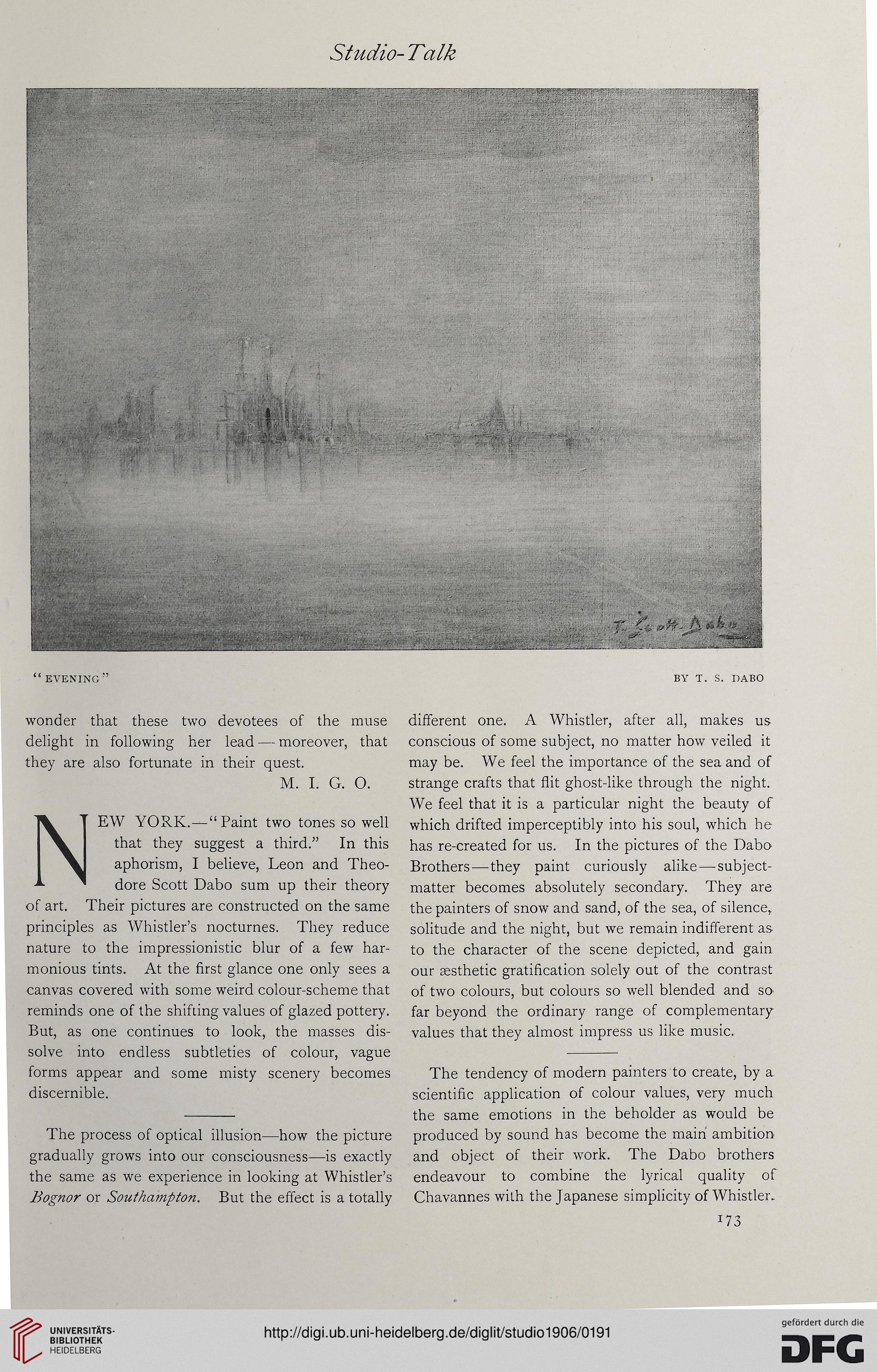Studio-Talk
“evening” by t. s. dabo
wonder that these two devotees of the muse
delight in following her lead — moreover, that
they are also fortunate in their quest.
M. I. G. O.
NEW YORK.—“Paint two tones so well
that they suggest a third.” In this
aphorism, I believe, Leon and Theo-
dore Scott Dabo sum up their theory
of art. Their pictures are constructed on the same
principles as Whistler’s nocturnes. They reduce
nature to the impressionistic blur of a few har-
monious tints. At the first glance one only sees a
canvas covered with some weird colour-scheme that
reminds one of the shifting values of glazed pottery.
But, as one continues to look, the masses dis-
solve into endless subtleties of colour, vague
forms appear and some misty scenery becomes
discernible.
The process of optical illusion—how the picture
gradually grows into our consciousness—is exactly
the same as we experience in looking at Whistler’s
Bognor or Southampton. But the effect is a totally
different one. A Whistler, after all, makes us
conscious of some subject, no matter how veiled it
may be. We feel the importance of the sea and of
strange crafts that flit ghost-like through the night.
We feel that it is a particular night the beauty of
which drifted imperceptibly into his soul, which he
has re-created for us. In the pictures of the Dabo
Brothers—they paint curiously alike—subject-
matter becomes absolutely secondary. They are
the painters of snow and sand, of the sea, of silence,
solitude and the night, but we remain indifferent as
to the character of the scene depicted, and gain
our aesthetic gratification solely out of the contrast
of two colours, but colours so well blended and so
far beyond the ordinary range of complementary
values that they almost impress us like music.
The tendency of modern painters to create, by a
scientific application of colour values, very much
the same emotions in the beholder as would be
produced by sound has become the main ambition
and object of their work. The Dabo brothers
endeavour to combine the lyrical quality of
Chavannes with the Japanese simplicity of Whistler.
I73
“evening” by t. s. dabo
wonder that these two devotees of the muse
delight in following her lead — moreover, that
they are also fortunate in their quest.
M. I. G. O.
NEW YORK.—“Paint two tones so well
that they suggest a third.” In this
aphorism, I believe, Leon and Theo-
dore Scott Dabo sum up their theory
of art. Their pictures are constructed on the same
principles as Whistler’s nocturnes. They reduce
nature to the impressionistic blur of a few har-
monious tints. At the first glance one only sees a
canvas covered with some weird colour-scheme that
reminds one of the shifting values of glazed pottery.
But, as one continues to look, the masses dis-
solve into endless subtleties of colour, vague
forms appear and some misty scenery becomes
discernible.
The process of optical illusion—how the picture
gradually grows into our consciousness—is exactly
the same as we experience in looking at Whistler’s
Bognor or Southampton. But the effect is a totally
different one. A Whistler, after all, makes us
conscious of some subject, no matter how veiled it
may be. We feel the importance of the sea and of
strange crafts that flit ghost-like through the night.
We feel that it is a particular night the beauty of
which drifted imperceptibly into his soul, which he
has re-created for us. In the pictures of the Dabo
Brothers—they paint curiously alike—subject-
matter becomes absolutely secondary. They are
the painters of snow and sand, of the sea, of silence,
solitude and the night, but we remain indifferent as
to the character of the scene depicted, and gain
our aesthetic gratification solely out of the contrast
of two colours, but colours so well blended and so
far beyond the ordinary range of complementary
values that they almost impress us like music.
The tendency of modern painters to create, by a
scientific application of colour values, very much
the same emotions in the beholder as would be
produced by sound has become the main ambition
and object of their work. The Dabo brothers
endeavour to combine the lyrical quality of
Chavannes with the Japanese simplicity of Whistler.
I73




